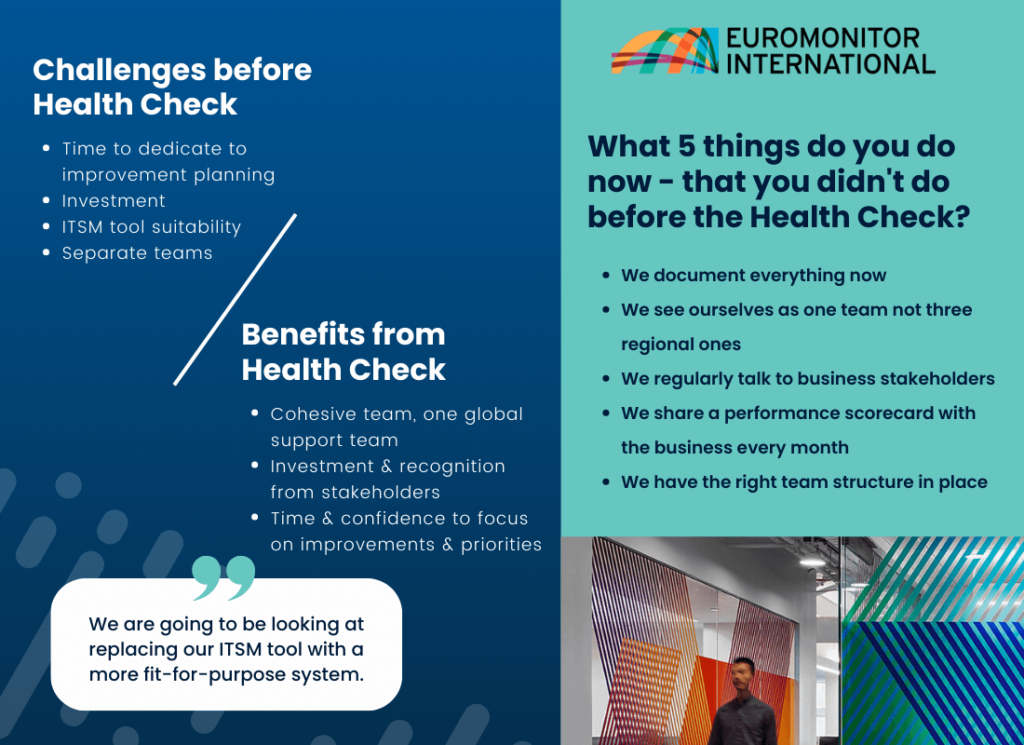 Back to Resources
Back to Resources
For many organisations, the service desk is the beating heart of the user experience. It is the centre of operations that keeps everything going smoothly. However, perceptions are not always the same as results.
Even if your service desk team meets all pre-defined performance metrics, this doesn’t mean they are realising their full potential – or that they are satisfied. As your team evolves, so do their experience and expectations.
➡️ Are you aware of the areas in which your team can improve?
➡️ Are you fully embracing a best practice culture and approach for your service desk?
If your service desk team is experiencing some of these challenges:
- Inconsistent process adherence due to a poorly established and maintained governance
- Poor adoption of or alignment to best practice frameworks or standards
- A lack of collaboration or effective knowledge management
- Insufficient first contact resolution performance
… it’s time to take steps to turn things around.
In this article, we will explore effective ways to manage some of the common challenges a service desk teams face. We will also provide insights on establishing good working practices and share some inspiring success stories.
So, keep reading!
✅ How to recognize that your team needs improvement?
✅ How to build an effective team?
✅ Are you ready to transform your IT service desk team?
The importance of effective leadership to your Service Desk Team
Having a very well-managed and lead service desk team can bring many advantages. When managed effectively and with well-communicated and defined goals, the service desk can be a crucial strategic asset for any organisation.
A service desk helps enhance the end-user experience, enabling a flexible and consistent approach to user support by forecasting and managing demand, improving organisational efficiency by returning end users to an operational state, and providing knowledge and information to enable end users to help themselves.
This can lead to quicker response times, faster incident resolution, and improved business productivity, which can increase satisfaction with the service desk and overall service provider.
Effective people management is crucial in promoting a positive work culture and keeping employees happy. Strong empathetic leadership, ongoing people and career development, and open communication are key factors in achieving this.
Finally, investing in employee well-being by actively providing support, recognising their value, and fostering engagement, cultivate a positive work environment. This, in turn, leads to demonstrably higher levels of job satisfaction and decreased employee turnover (negative attrition).
As talent retention is vital to organisational success, prioritising these efforts ensures that your top performers remain motivated and committed to your company.
How To Recognise That Your Team Needs Improvement
Now that we understand the significance of a well-managed and led service desk team, you might wonder:
How can I tell if my service desk team is struggling to keep up with the organisation’s demands?
What warning signs should I look out for?
Teams that are not managed effectively can quickly become disorganised and ineffective. This often results in frustrated and unmotivated employees, poor time management, lack of efficiency, high staff turnover rates, and poor end-user perception and experience.
Let’s look at the most common challenges and warning signs.
⚡ Let’s start with a few questions. Take a minute to answer them.
🔹 Has someone from your team encountered a situation where there were no documented processes or procedures for logging and managing IT issues?
🔹 Is your team repeatedly searching for solutions to the same IT issues due to a lack of centralised knowledge sharing and timely access to information?
🔹 Does your service desk team often feel demotivated and unsatisfied with their work?
🔹 Does your team often encounter situations where a technical issue takes longer than expected to resolve, affecting business operations?
🔹 Are your teams constantly escalating tickets to support teams or other departments?
🔹 Does a lack of integration exist between your ITSM tool and other business tools or systems?
🔹 Is your ITSM tool configured well enough to support your operational process and working practices?
🔹 Is there a mismatch between agreed performance measures and user expectations and demands?
🔹 Are you unable to generate meaningful and timely management information, meaning your reports are a barrier to you making sustainable continual improvements?
🔹 Does your ITSM tool lack the functionality to provide you with real-time information to enable fast and effective ‘in-flight” decisions?
🔹Do you have an inconsistent approach to user and customer experience across the support organisation?
🔹 Are you able to easily and effectively capture feedback at all levels and from multiple channels to ensure your operational, tactical and strategic approach is meeting the needs and required outcomes of the business?
🔹 Is continual improvement inconsistent as it is not underpinned by an agreed process or supported by a robust and recognised continual improvement register?
⚠️ If you answered positively more than twice, these might be your warning signs – and if ignored, they could turn into something more serious.
But you’re not alone. Managing service desk teams can be a very complex and challenging process.
Many organisations struggle with inconsistent processes, inefficient tools, lack of documentation, siloed knowledge, poor communication or collaboration, training, and development, overlooking end-user experience feedback or a transactional mentality.
Implementing some key best practices can transform your IT service desk and boost efficiency, customer satisfaction, and team morale.
How to Build an Effective Team
The good news is that these challenges are not impossible to overcome.
You can create a thriving service desk team by implementing best practice, conducting regular self-assessments, and gathering end-user feedback to identify bottlenecks and opportunities. So, don’t be afraid to embrace tools like benchmarking against industry standards.
Many of SDI’s customers have experienced extremely positive change as a result of embracing such an approach.
Now, let’s look at some success stories and good working practices you could implement today.
#1 Embrace best practice
This might seem the most obvious advice, but most organisations still need help adopting the industry-best practice to ensure consistency, efficiency, and the quality of service they deliver.
Frameworks like Service Desk Certification, ITIL®, Verism, Cobit, KCS, and others offer proven methodologies for streamlining processes, managing knowledge, and improving service delivery.
Take a close look at your current processes and find ways to improve them.
➡️ Define procedures and training objectives in place to encourage teamwork in the organisation.
➡️ Create a structured onboarding process to ensure new staff feel valued and part of the business.
➡️ Have a documented and measurable employee satisfaction program in place that’s regularly scheduled, reviewed, and updated.
➡️ Have well-defined and documented processes that are measurable, communicated, and accessible to stakeholders. These processes include incident and service request management, quality improvement, knowledge capture, change control, and problem management.
#2 Unlock the true potential of accreditation
Achieving accreditation against international standards, like the SDI’s Service Desk Certification programme, demonstrates an organisation’s commitment to quality and provides a roadmap for continual improvement.
This also provides a safety net for customers as they will trust your team’s abilities and skills, boosting their morale and motivation.
CGI’s Success Story

CGI UK is a great example of the transformative power of accreditation. With a brilliant team exceeding 400 service desk analysts and management, CGI UK recently achieved a remarkable milestone – a 99.99% score in the Service Desk Certification programme.
Since securing the SDI’s 5-star accreditation in 2012, they have set the standard for service desks globally. Not only have they maintained this standard, but they have also consistently delivered exceptional services to their clients.
If we only look at the numbers, their operational efficiency is evident. Annually, they handle an incredible 1.5 million contacts, managing 18,000 changes and proactively addressing 800 problems annually. Equally remarkable is CGI UK’s client satisfaction score, which exceeds 93%.
So, there, you have an organisation that is fully utilising the power of Service Desk Certification.
#3 Don’t ignore the power of knowledge management
If your team spends hours searching for solutions to known incidents and service requests instead of consulting a centralised knowledge base, they waste valuable time and resources.
That’s a clear sign that your knowledge management practices need improvement.
Start by creating a centralised knowledge base – a robust, easily accessible, and regularly updated knowledge base. Think of it as your team’s point of truth, which is important for your current team members and future ones, as it helps with onboarding.
But don’t stop just there. Encourage collaboration and knowledge sharing among team members to effectively capture and disseminate best practices.
Power Design’s Documentation Evolution

One of the most significant shifts within the Power Design Inc service desk since embarking on the SDC journey has been the maturation of their approach to processes and documentation.
Prior to the SDC program, Power Design relied heavily on word of mouth and tacit knowledge. However, the program’s emphasis on evidence-based practices has propelled them towards a more consistent and reliable support experience.
Documenting the ‘how,’ ‘what,’ and ‘why’ behind their operations has not only fostered consistency but has also enabled them to define clear career paths, roles, and responsibilities.
This is an excellent example of how diligently documenting processes, procedures, and continuous improvement efforts can enhance transparency within a department and ensure knowledge sharing across the board. Power Design’s proactive approach has ensured that vital information is now accessible to everyone within the organisation.
Overall, Power Design’s journey with the SDC program highlights the importance of objective evaluation, continuous improvement, and collaborative efforts in enhancing service desk operations and delivering exceptional customer experiences.
#4 Prioritise employee experience and well-being
Losing experienced employees on a regular basis is a clear indication that there are underlying issues within your team.
Let’s face it: if your employees feel like they’re not getting the recognition they deserve, or they’re super stressed out, or they don’t see any potential for career growth, they’re more likely to “shut down” and disengage – and eventually leave.
Retaining top talent requires recognising the importance of work-life balance and employee satisfaction. So, consider offering flexible work arrangements, providing career growth and advancement opportunities, and regularly acknowledging and providing feedback on contributions to foster a positive work culture.
DVSA’s Focus on Service Desk Team Well-Being

Over the last two years, DVSA, an executive agency of the UK Department of Transport (DfT), has put user experience at the heart of everything they do. To enhance their skills and capabilities in providing technical support and assistance to end users, they decided to participate in the SDC programme.
There are several key changes that they have made since starting their improvement journey.
From merging 1st Line Support and 2nd Line Support into a more technical Service Desk, introducing a User Experience Team and Business Relationship Management Team to standard process and enhanced reporting.
However, one thing that stood out is their commitment to ensuring that the team feels valued and recognised for their work. They achieve this by regularly conducting surveys to gather staff feedback and prioritising supporting a healthy work/life balance for their service desk teams.
📕 READ CASE STUDY: DVSA’S’ Certification Journey
#5 Choose the right ITSM tool
Invest in a robust ITSM tool that aligns with your needs and offers features like incident management, knowledge management, automation, and reporting. But remember, choosing the right tool is just one important step. It is equally important to ensure that it is implemented correctly.
Consult with your team and ensure that the tool has all the features to make their day-to-day work more efficient and less administratively intensive. Once implemented, ensure that the whole team gets proper training and can use the tool efficiently.
Euromonitor’s Journey with the SDI Health Check Service

Euromonitor is another great example of a company striving to improve. To get a clear picture of where they stood and where they needed to go, they started their improvement journey with the SDI Health Check Service.
The impact? Well, for starters, they’ve significantly improved their incident response and resolution numbers. They eliminated a long-standing issue with too many aged tickets in the system.
They’ve also streamlined their workflow, with more consistency in how they tackle their workload.
But, thanks to the gained insights from the Service Health Check, Euromonitor has also discovered the need for a new ITSM tool. An ITSM tool that is more tailored to their needs.
#6 Communicate, collaborate, celebrate
Promote a culture of continuous learning and development within the team. Focus on creating a culture of open communication and collaboration within your team.
For example, you could do regular “pulse surveys” where employees are able to provide feedback to leadership anonymously. Think about it as an engagement survey that will help you identify what drives employee engagement and what actions you can take based on employee feedback.
⚡Here are some easy questions that you can include in your next pulse survey:
🔹 How would you rate the culture within our organisation?
🔹 Are you satisfied with the decision-making processes within our organisation?
🔹 Do you have confidence in our leadership team’s abilities?
🔹 Does our organisation do a good job of communicating with employees?
🔹 Do your strengths match well with my role?
🔹 Do you have the resources you need to perform your job effectively?
🔹 Do you feel satisfied with the recognition or praise you receive for your work?
🔹 Do you feel empowered to make decisions regarding your work?
Regularly sharing and celebrating your team’s successes and addressing challenges transparently can foster trust and create a thriving work environment.
Are you ready to transform your IT service desk team?
A well-managed service desk team ensures consistent, high-quality customer service, boosting customer satisfaction, building trust, and creating positive experiences.
Take a moment to reflect on some of these warning signs, examples, and tips and consider how you can support your service desk teams to thrive.






















